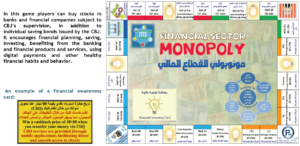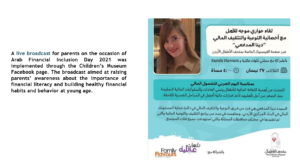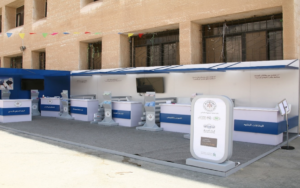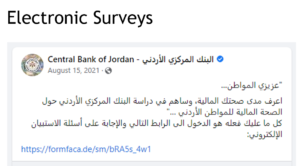By Ola Khalil and Dina Madfai, Financial Consumer Protection Department, Central Bank of Jordan
The global pandemic has exposed some of the prevailing financial vulnerabilities faced by people living in Jordan. Financial literacy – especially adequate planning, saving, and decision-making – is crucial to withstanding financial hardship during unforeseen crises. Even before the pandemic, the Central Bank of Jordan (CBJ) started capitalizing on the potential of financial education initiatives, to equip Jordanian society with the tools needed to achieve financial resilience. Here’s a closer look at the practical implementation of some of these initiatives, what they have achieved, and how they feed into the country’s existing financial inclusion policies.
Financial education in Jordanian schools
As a first step in creating a financially savvy future generation, 7th grade students across Jordan started receiving financial education in 2015. The curriculum aims to provide learners with the basic principles of responsible money management, including financial planning, decision-making, and entrepreneurship. Classes form part of the National Financial Education Project (NFEP) – a joint initiative rolled out by CBJ, Jordan’s Ministry of Education (MOE), and INJAZ, a local non-profit organization that has been working on education for over 20 years. The NFEP is funded by local NGOs and banks operating in Jordan. In 2019, the NFEP expanded financial education to include grades 7 to 12.
In 2017, Jordan adopted its first National Financial Inclusion Strategy (NFIS), with financial education as a principal priority. In the NFIS, Jordan committed to increasing the share of adults owning bank accounts to 41.5 percent in 2020 from the initial 33.1 percent in 2017, and to decrease the gender gap in account ownership from 53 percent to 35 percent.
The NFEP and the NFIS complement each other’s objectives. While the NFIS creates an environment fit for scaling up financial education policymaking, the NFEP provides a key ingredient for achieving the NFIS’s long-term goal: a financially informed and inclusive society. And the effects of this symbiosis are already being felt, with adult account ownership hitting 43.1 percent in 2022 – that’s two percent higher than the NFIS’ goal for 2020 – and a reduced gender gap of 22 percent – a 13 percentage point improvement on the NFIS’ earlier target.
CBJ meeting financial literacy needs across the board
The tools and channels used to deliver financial literacy are tailored to suit the needs of each targeted segment. In schools, children’s centers, and orphan care associations, for instance, the CBJ makes use of fun activities like board games and drawing competitions to encourage kids to partake in financial literacy lessons.

The CBJ’s financial literacy activities also reach beyond schools. Youth, women, the elderly, persons with disabilities, and refugees are all prioritized through our financial literacy campaigns, many of which coincide with major regional and international occasions. On Arab Day for Financial Inclusion, for instance, we hosted financial literacy talks for students at university campuses while on International Women’s Day and Mother’s Day, we organized events in urban and rural areas to address women’s financial literacy.

We also host regular awareness-raising sessions at centers dedicated to women, children, and persons with disabilities, as well as in factories and other workplaces. Briefings for people with disabilities are specifically aimed at informing attendees of the availability, access, and usage of banking services and facilities that suit their needs, such as locations where ramps are provided, ATMs with adjusted heights, and talking ATMs. The CBJ also sets up financial advisory booths in shopping centers and bazaars, providing women with safe, readily available, and easily accessible financial guidance. Booths were also utilized at several public and private universities in different governorates for campaigns targeting youth.

Two additional priority groups include forcibly displaced persons and the elderly. As part of our financial literacy initiatives, the CBJ has helped develop the digital payment infrastructures and national strategies needed to grant displaced persons access to online bank accounts, investments, and other financial services, with regular refugee camp visits to guide displaced persons in how to best benefit from these products and services. CBJ has also joined the National Committee on Strategy for Older Persons to promote digital financial literacy among elderly people.
AFI’s knowledge products like the Financial Competency Matrix for Adults and the Financial Competency Matrix for Children and Youth serve as part of the theoretical foundation for the development of CBJ’s financial literacy programs¹. During a recent financial literacy session at a university in Jordan for example, where students were lectured on the seven themes and four components of financial competency by experts from our various CBJ departments.
Using digital tools to foster financial literacy
At CBJ we take advantage of digital tools like videos and animation for promoting financial literacy. A series of videos were released for International Women’s Day in 2021 (“Electronic payment services, smart and easy solutions”, see videos 1, 2, 3 and 4), while several videos were developed in 2020/21 as part of an awareness raising campaign on how to avoid financial fraud (“Protect yourself from electronic financial fraud”, see videos 1, 2 and 3). Other digital campaigns include electronic surveys, quizzes, competitions, electronic financial literacy sessions, and live broadcasts.
Digital channels for delivering financial literacy have gained increasing momentum since the start of the COVID-19 pandemic. Our website and Facebook page, as well as the websites and social media accounts of our partners, regularly publish content to raise awareness about financial literacy in Jordan. Moreover, we encourage banks and non-banking financial institutions to implement their own financial literacy programs, mainly on social media or by sending financial awareness messages to their clients via SMS.
Measuring the impact of financial literacy programs
Using AFI’s Financial Education Programs Monitoring and Evaluation Toolkit, we chose specific tools tailored to the needs of various target groups to measure the impact, effectiveness, and efficiency of their respective financial literacy programs¹. For students, for instance, we turned survey questionnaires into electronic quizzes, covering all the themes introduced during their course. Quizzes – as opposed to surveys – encouraged students to engage more enthusiastically in the evaluation process.

Additionally, by using the OECD/INFE Toolkit for Measuring Financial Literacy and Financial Inclusion, we can track the long-term impact of our programs on individuals’ financial health, skills, attitudes, and behavior. CBJ implemented this survey for the first time in 2020 and will re-implement it again in 2023 by participating in a coordinated international survey. Furthermore, the continuous monitoring of CBJ’s programs provides us with a more holistic understanding of the resulting financial resilience achieved by families across Jordan.
A study from the Brookings Institution, in collaboration with INJAZ, CBJ, and MOE, revealed some of the factors related to the NFEP’s success, including a public-private partnership model that broke with traditional ways of working by bringing together a diverse range of actors to contribute to funding, advocacy, and implementation; an extended timeframe to continuously test and refine the NFEP’s approach; support from a global movement for financial inclusion alongside a local environment ready to facilitate scaling; and finally, flexibility among all parties to adapt plans and react to a changing context in the wake of a global pandemic.
On the horizon
In 2023 we’ll be looking forward to the implementation of various new components to the CBJ’s financial literacy programs, including a financial literacy test for students based on OECD’s PISA Program for International Student Assessment, and a new coordinated financial literacy survey focused specifically on adults. Prospects for Jordan’s financial literacy initiatives include an increased focus on topics relating to insurance, fraud avoidance, and digital payment tools for currency exchange businesses. Last but not the least, Jordan will create an online platform dedicated entirely to promoting financial literacy across Jordan, while at CBJ we plan to continue measuring the overall progress and impact of our financial literacy programs on Jordanian society.
CBJ’s continued collaboration with the Jordanian government, the private sector, civil society, and other stakeholders is key to our progressive success in advancing financial literacy and building a more resilient Jordanian society. Only by working together on making the world more financially inclusive can we get closer to achieving the United Nations Sustainable Development Goals.
___________
¹AFI’s publications – Financial Competency Matrix for Adults, Financial Competency Matrix for Children and Youth, and Financial Education Programs Monitoring & Evaluation Toolkit – provide policy guidance based on financial competencies (knowledge, skills, attitude, and behavior), and practical examples to guide key stakeholders through the process of assessing the performance of national financial education, literacy, and capability programs.

 About
About
 Online
Online
 Data
Data






















